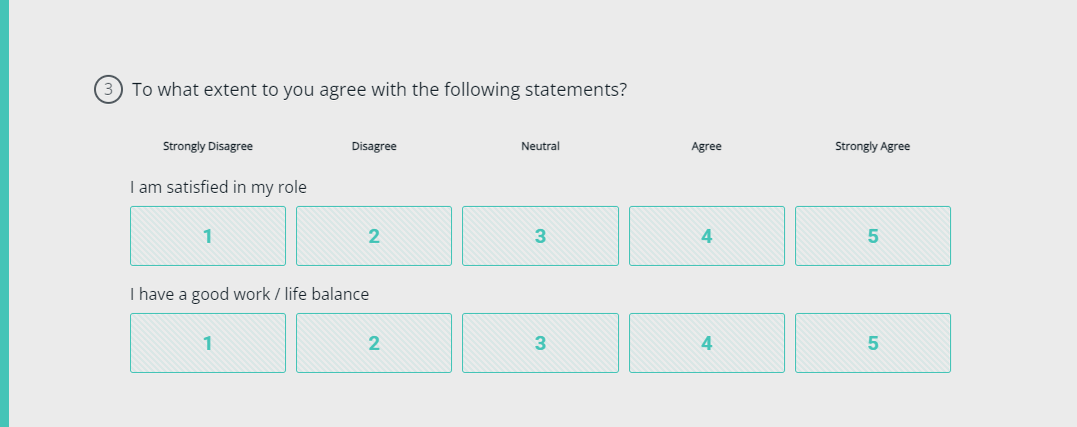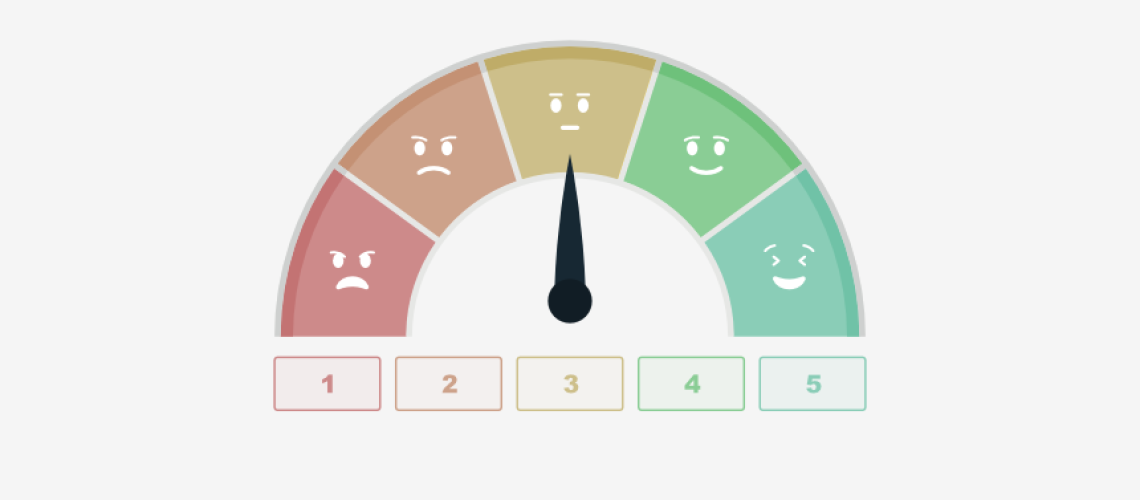Rating scales play a pivotal role in survey research, serving as the bedrock for collecting valuable insights and opinions from respondents.
As researchers strive to design surveys that yield accurate and meaningful data, the choice between numbered and worded rating scales becomes a critical decision.
This article delves into the nuances of these two types of rating scales, exploring their respective strengths and weaknesses.
Table of Contents
What are rating scales?
Rating scales are closed-ended questions designed to measure and collect data about various characteristics, opinions, or attitudes of respondents.
They provide a systematic way for individuals to express their opinions or preferences on a scale, allowing researchers to quantify and analyze responses.
Numbered rating scales
Numbered rating scales, often referred to as quantitative scales, involve assigning numerical values to responses.
These scales provide a structured format for respondents to express their opinions, perceptions, or attitudes by selecting a specific numeric option.

Advantages of numbered scales
Precision and clarity
Numbered rating scales offer a clear and precise way of quantifying responses. The numerical values provide a straightforward measurement that aids in data analysis.
Ease of analysis
The simplicity of numerical data facilitates easier statistical analysis. Researchers can apply mathematical operations, such as calculating averages or conducting statistical tests, with greater ease.
Universal application
Numbers have a universal understanding, minimizing the risk of misinterpretation across different cultures and languages. This makes numbered rating scales particularly useful in multicultural or global research projects.
Disadvantages of numbered scales
Potential for response bias
Respondents may exhibit a tendency to choose responses in the middle of the scale (central tendency bias) or opt for extreme values (extreme response bias), impacting the reliability of the data.
Limits expressiveness
Numbered scales might lack the depth needed to capture nuanced opinions or emotions. Respondents may find it challenging to convey subtleties in their feelings through a numeric selection.
Lacks qualitative nuance
They may struggle to capture qualitative aspects of responses. They are primarily quantitative, making it difficult to extract detailed qualitative insights from participants.
Worded rating scales
Worded rating scales, also known as qualitative scales, rely on descriptive terms or phrases instead of numerical values.
Respondents select the phrase or term that best aligns with their opinions, providing a more qualitative and nuanced perspective.

Advantages of worded scales
Richer in opinion
Worded rating scales allow respondents to convey the depth and nuance of their opinions through descriptive language. This richness can provide valuable insights beyond the limitations of numerical scales.
Flexible context
Researchers have the flexibility to customize worded scales to fit the specific context of their study. This adaptability makes worded scales well-suited for surveys with unique objectives or diverse participant groups.
Minimize response bias
Worded scales can reduce certain types of response biases associated with numerical scales. Participants may find it easier to select phrases that resonate with their feelings, potentially minimizing central tendency or extreme response biases.
Disadvantages of worded scales
Language can be subjective
The subjective nature of worded scales introduces interpretation challenges. Respondents may interpret terms differently, leading to variability in their selections.
Less open to interpretation
In cases where each point along the scale is assigned text, your results will be less open to interpretation, which can be more restrictive.
Cultural and language variations
Worded scales may be sensitive to cultural and language variations, as the meaning of certain terms can differ across diverse populations. Researchers must be cautious about potential misinterpretations.
The different types of rating scales
For clarity, let’s go over more types of rating scales available in surveys.
1. Numerical rating scales
This type of rating scale involves assigning numerical values to indicate the degree of agreement, satisfaction, or any other measured attribute.
For example:
- Likert scales (e.g., 1 to 5 or 1 to 10)
- Numeric scales (e.g., 0 to 100)
- Scales with specific anchors (e.g., 0 = strongly disagree to 5 = strongly agree).

2. Other worded rating scales
In contrast to numerical scales, worded scales use descriptive terms or phrases to capture respondent sentiments. Participants select the phrase that best represents their opinion.
For example:
- Semantic differential scales (e.g., excellent to poor)
- Adjective scales (e.g., very satisfied to very dissatisfied)
- Qualitative scales (e.g., excellent, good, fair, poor).

3. Likert scales
Likert scales are a specific type of numerical rating scale that measures agreement or disagreement with a statement.
Respondents select from a range of options, typically five or seven, indicating their level of agreement.
An example of the response options available would be:
- Strongly disagree = 1
- Disagree = 2
- Neither agree nor disagree = 3
- Agree = 3
- Strongly agree = 5

There is an argument to be made that bias can be created when numbers are used with Likert scales, so these can be switched to letters.
- Strongly disagree = A
- Disagree = B
- Neither agree nor disagree = C
- Agree = D
- Strongly agree = E

4. Bipolar rating scales
Also known as bipolar adjective scales, these scales present opposing adjectives or phrases at each end.
Respondents mark a point along the continuum that reflects their position.
The Net Promoter Score question uses this very scale. When customers are asked how likely they are to recommend a product or service, 0 equals “Not at all likely” and 10 equals “extremely likely”.

5. Numeric scales
Whilst the name is strikingly similar to Numerical scales, Numeric scales use no wording at all within the scale itself.
A question or statement is made, and then it’s up to respondents to assign the meaning of a value along a scale.
For example:
- 1 – 10
- 1 – 100
- 0 – 5

The kinds of questions are often used in climate surveys to measure the experiences of people within an organization.
How to choose the right rating scale
There’s no clear cut answer here, it really depends on what’s best for your research and preferences.
You’ll have seen that most specific types of rating scales are mix of numbers and wording.
And maybe there’s some insight in that.
Customer satisfaction surveys often use a mix of qualitative and quantitative elements in their scales. The wording is to provide context to at least each end of the scale, and the rest is defined by the customer.
The beauty in this is that you can use answers to other survey questions to interpret the results of rating scale questions.
How to create a rating scale survey
With FreeOnlineSurveys, it couldn’t be easier to a rating scale survey.
Simply:
- Select the Survey project type
- Go to the Build section
- Click New Question in the left sidebar
- Select Matrix or Opinion Scale
The Matrix question type is essentially a Likert Scale, where both text and numbers are present for each point along the scale.
The Opinion Scale question type is a Bipolar rating scale, where text can be input at the extremes of the scale.
You can customize the number of points along the scale for both question types, for example a 0-10 or 1-5 rating scale.
Start Creating Surveys for Free Today!
Wrapping up
Rating scales are among the most frequently used question types in online surveys. And for good reason, they provide quantifiable insights on your respondents.
One thing we should mention before we pack up, is that most rating scales have a positive and negative extreme.
If a scale is all positive (or negative) it’s likely that you’ve created a leading question, which are a world of trouble in their own right.
If you think we’ve left anything out, don’t hesitate to get in touch and let us know.

